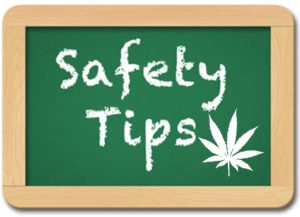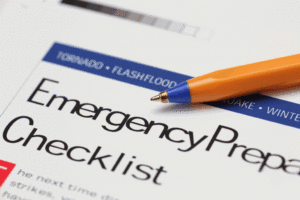
Crowd-related injuries can occur during special cannabis sales and promotional events so dispensary employers are responsible for providing their workers with safe and healthy workplaces. Employers are encouraged to adopt effective safety and health programs to identify and eliminate work-related hazards, including those caused by large crowds at retail sales events.
These guidelines help employers and retail dispensary owners avoid injuries during the holiday shopping season or other cannabis industry events where large crowds may gather. Crowd management planning should begin in advance of events that are likely to draw large crowds, and crowd management, pre-event setup, and emergency management should be part of event planning.
It is recommended that employers planning a large shopping event adopt a plan that includes the following elements.
Planning
-

Organize Actions During Workplace Emergencies Where large crowds are expected, hire additional staff as needed and have trained security or crowd management personnel or police officers on site.
- Create a detailed staffing plan that designates a location for each worker. Based on the size of
the crowd expected, determine the number of workers that are needed in various locations to ensure the safety of the event (e.g., near the entrances and throughout the store). - Ensure that workers are properly trained to manage the event.
- Contact local fire and police agencies to determine if the event site meets all public safety
requirements, and ensure that all permits and licenses are obtained and that local emergency services, including the local police, fire department, and hospital, are aware of the event. - Designate a worker to contact local emergency responders if necessary.
- Designate a store manager to make key decisions as needed during the event.
- Provide legible and visible signs that describe entrance and exit locations, store opening times, and other important information such as the location of major sale items and restrooms.
- Prepare an emergency plan that addresses potential dangers facing workers, including overcrowding, crowd crushing, being struck by the crowd, violent acts, and fire. Share the emergency plan with all local public safety agencies.
- Train workers in crowd management procedures and the emergency plan. Provide them with an opportunity to practice the special event plan. Include local public safety agencies if appropriate.
Pre-Event Setup
 Set up barricades or rope lines for crowd management well in advance of customers arriving at the store.
Set up barricades or rope lines for crowd management well in advance of customers arriving at the store.- Make sure that barricades are set up so that the customers’ line does not start right at the entrance to the store. This will allow for orderly crowd management entry and make it possible to divide crowds into small groups to control entrance.
- Ensure that barricade lines have an adequate number of breaks and turn at regular intervals to reduce the risk of customers pushing from the rear and possibly crushing others, including workers.
- Designate workers to explain approach and entrance procedures to the arriving public, and direct them to lines or entrances.
- Make sure that outside personnel has radios or some other way to communicate with personnel inside the store and emergency responders.
- Consider using mechanisms such as numbered wristbands or tickets to provide the earlier-arriving customers with first access to sale items.
- Consider using the Internet lottery for “hot” items.
- Locate sale items in different parts of the store to prevent overcrowding in one place.
- Locate shopping carts and other potential obstacles or projectiles inside the store and away from the entrance, not in the parking lot.
- If appropriate, provide public amenities including toilets, washbasins, water, and shelter.
- Communicate updated information to customers waiting in line. Have signs and distribute pamphlets showing the location of entrances, and exits, store opening times, and the location of special sales items within the store.
- Shortly before opening, remind waiting crowds of the entrance process (i.e., limiting entry to small groups, the redemption of numbered tickets, etc.).
During Sales Event
 Provide a separate store entrance for staff. Provide door monitors there to prevent crowd entry.
Provide a separate store entrance for staff. Provide door monitors there to prevent crowd entry.- Make sure that all employees and crowd control personnel are aware that the doors are about to open.
- Staff entrances with uniformed guards, police, or other authorized personnel.
- Use a public address system or bullhorns to manage the entering crowd and to communicate information or problems.
- Position security or crowd managers to the sides of entering (or exiting) the public, not in the center of their path.
- Provide crowd and entry management measures at all entrances, including the ones not being used. If possible, use more than one entrance.
- When the store reaches maximum occupancy, do not allow additional customers to enter until the occupancy level drops.
- Provide a safe entrance for people with disabilities.
Emergency Situations
 Do not restrict egress, and do not block or lock exit doors.
Do not restrict egress, and do not block or lock exit doors.- Know in advance who to call for an emergency medical response.
- Keep first-aid kits and Automated External Defibrillators (AEDs) available, and have personnel trained in using AEDs and CPR on site.
- Instruct employees, in the event of an emergency, to follow instructions from authorized first responders, regardless of company rules.
Protect Temporary Dispensary Workers
To ensure that there is a clear understanding of each cannabis dispensary employer’s role in protecting employees, it is recommended that the temporary staffing agency and the host employer set out their respective responsibilities for compliance with applicable safety standards in their contract. Including such terms in a contract will ensure that each employer complies with all relevant regulatory requirements, thereby avoiding confusion as to the employer’s obligations.
Joint Responsibility

While the extent of responsibility under the law of cannabis industry staffing agencies and host employers is dependent on the specific facts of each case, staffing agencies and host employers are jointly responsible for maintaining a safe work environment for temporary workers – including, for example, ensuring that occupational safety training, hazard communication training, and recordkeeping requirements are fulfilled.
Both the host and temporary employers are responsible for the violative condition(s) – and that can include a lack of adequate training regarding workplace hazards. Temporary staffing agencies and host dispensary employers share control over the worker and are therefore jointly responsible for temporary workers’ safety and health.
There are concerns that some employers may use temporary workers as a way to avoid meeting all their compliance obligations and other worker protection laws; that temporary workers get placed in a variety of jobs, including the most hazardous jobs; that temporary workers are more vulnerable to dispensary workplace safety and health hazards and retaliation than workers in traditional employment relationships; that temporary workers are often not given adequate safety and health training or explanations of their duties by either the temporary staffing agency or the host employer.
Therefore, both employers must comply with all relevant occupational safety requirements.
Employers and Staffing Agencies Have Roles
 Both host employers and staffing agencies have roles in complying with dispensary workplace health and safety requirements and they share responsibility for ensuring worker safety and health.
Both host employers and staffing agencies have roles in complying with dispensary workplace health and safety requirements and they share responsibility for ensuring worker safety and health.
A key concept is that each employer should consider the hazards it is in a position to prevent and correct, and in a position to comply with safety standards. For example, staffing agencies might provide general safety and health training, and host employers provide specific training tailored to the particular workplace equipment/hazards.
- The key is communication between the agency and the host to ensure that the necessary protections are provided.
- Staffing agencies must inquire into the conditions of their workers’ assigned workplaces. They must ensure that they are sending workers to a safe workplace.
- Ignorance of hazards is not an excuse.
- Staffing agencies need not become experts on specific workplace hazards, but they should determine what conditions exist at their client (host) agencies, what hazards may be encountered, and how best to ensure protection for the temporary workers.
- The staffing agency must inquire and verify that the host has fulfilled its responsibilities for a safe workplace.
- And, just as important: Host employers must treat temporary workers like any other workers in terms of training and safety, and health protections.
Let us know what you think.




Responses